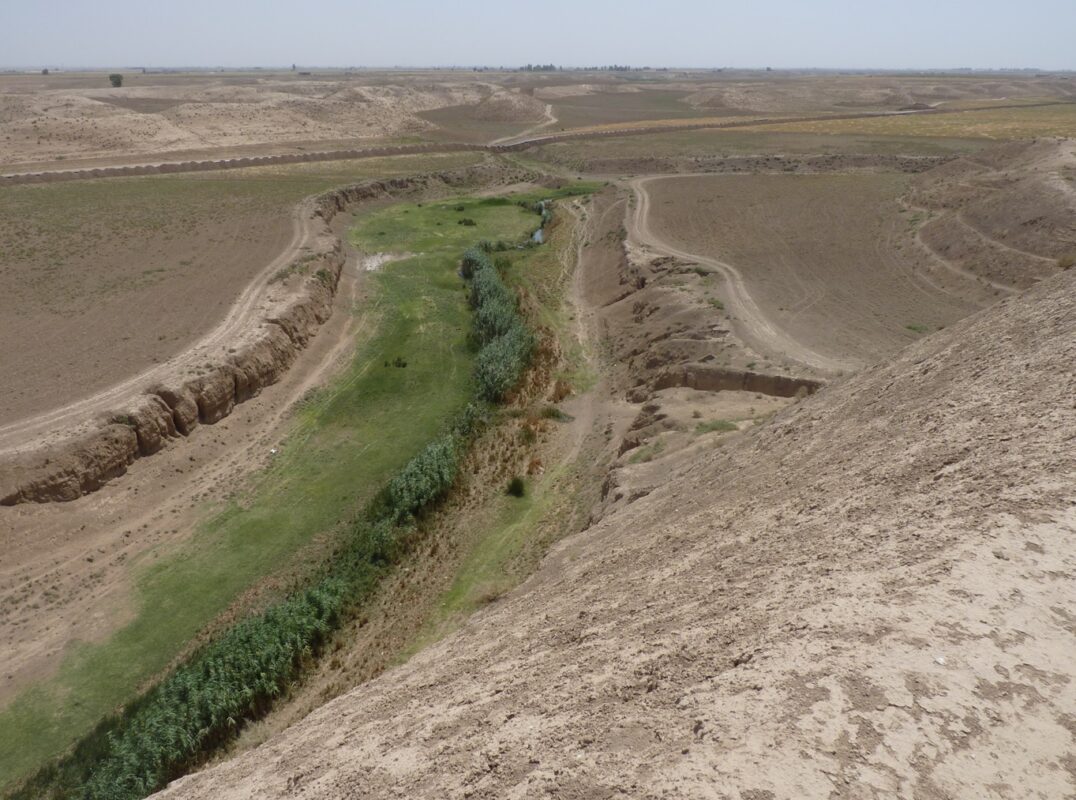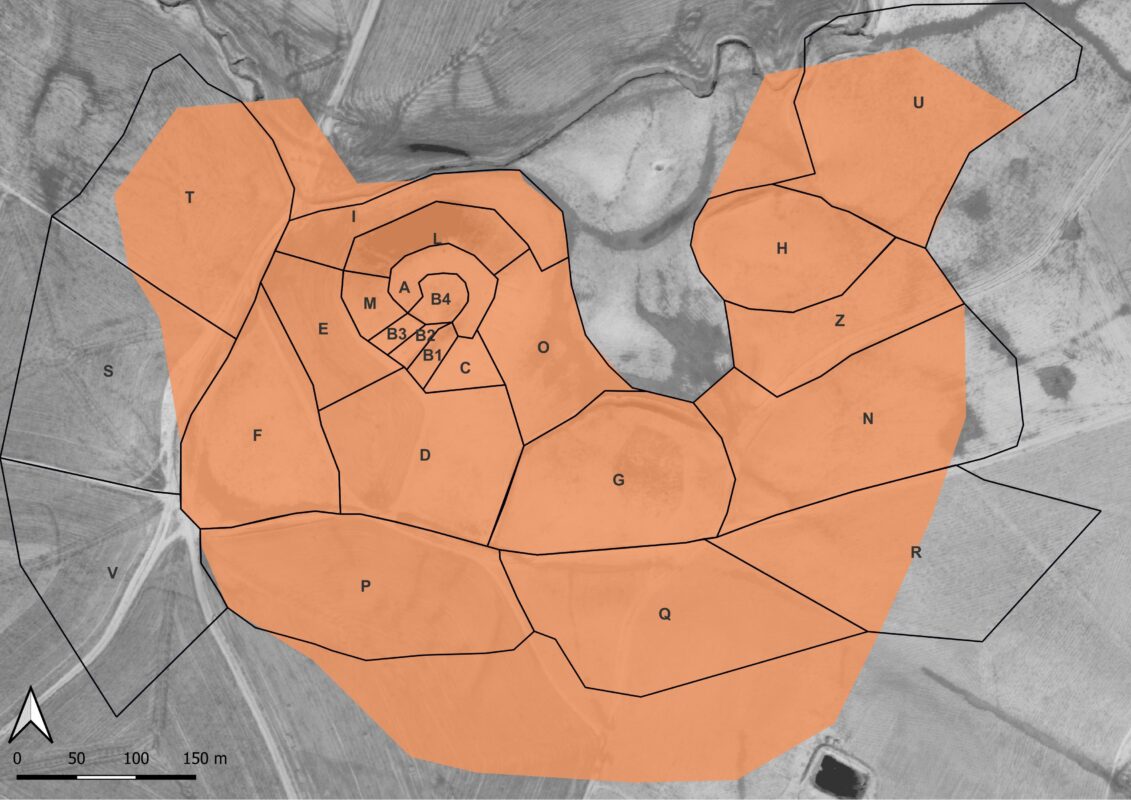During two brief fieldwork seasons in 2013 and 2015, a survey was conducted at the site of Helawa, while the site of Aliawa was investigated in 2015, 2016 and 2022 with the aim of reconstructing the chronological sequence of their occupations. Since 2019, geo-archaeological investigations were initiated in an area of 5 km per side and which includes both sites. The settlements are located in the meanders of two ancient water courses and are characterized by a small main artificial mound (the result of the stratification of the settlements throughout the millennia) and by lower extensions in their surroundings. The area of Helawa/Aliawa is part of the Kurdara’s hydraulic system, while to the north the largest water course is the Siwasor (both courses are tributaries of the Upper Zab). The plain is interrupted just to the east of Helawa and Aliawa by the low hills of Awena which run in a south-north direction and are parallel to a more eastern chain of hills which divide the Erbil and the Makhmour plains.
Helawa
The systematic survey of Helawa (site no. 272 in the survey conducted by Harvard University) has enabled the reconstruction of the occupational sequence and of the settlement’s extension throughout the different periods, allowing the investigation of the morphology of the artificial mound, formed by the superimposition of the different phases. The site is located in the meander of a river which delimitates it to the west and to the south-west and reaches 22 m in height above the surrounding plain. The presence of the modern village in proximity of the old settlement makes investigating its maximum extension difficult, although it surely exceeded 5 hectares and was probably a little less than 10 hectares. The slopes are much steeper to the south in direction of the water course, while they are less abrupt especially to the north and to the east.
More than 1700 diagnostic pottery sherds and 600 finds were filed and compiled into the archaeological GIS. These materials derive from 60 superficial sample geo-referenced collection units which were chosen in order to achieve a full coverage of the site.
The earliest occupation documented by the materials collected from the surface dates to the 7th millennium BC, i.e. to the Hassuna/Samarra periods (Helawa I) and, later, to the Halaf period (end of 6th-beginning of 5th millennium BC) (Helawa II). The Ubaid pottery (end of 6th-beginning of 5th millennium BC) suggests a still rather small frequentation limited to the central area of the mound (Helawa III), while during the Late Chalcolithic 1-3 (5th-4th millennia BC) the settlement increased in size, reached is maximum dimensions and was eventually abandoned during the LC 3 (Helawa IVA-C). There is no evidence of pottery datable to the period between the second half of the 4th and the mid-2nd millennia BC, indicating that Helawa must have been abandoned for more than two thousand years.
It is only during the advanced Middle Bronze Age (around the 16th century BC) that Helawa is once again inhabited by what appears to be a rural settlement covering the whole area (Helawa V). Such an occupation was short-lived as it did not last beyond the beginning of the 14th century BC (Late Bronze Age I, Helawa VI). A few Islamic pottery sherds, moreover, indicate a limited presence on the top of the mound (Helawa VII).
The analysis of the finds’ distribution has also yielded significant evidence of craft activities with furnace wasters, tools and flint and obsidian flakes scattered in the middle section of the southern slope. This data suggests the presence of workshops in that area during the early Late Chalcolithic, a hypothesis which was later confirmed during the excavation of Step Trench B.
Aliawa
Aliawa (Site n. 246 in the survey conducted by Harvard University) is located in the south-western Erbil plain close to a water course which forms a meander that flanks the site on its western side. The main mound is 25 m high, is approximately 2 hectares in extension and features steep slopes on the north, east and west sides, while to the south they are are more gentle.
The survey has demonstrated that the ancient settlement’s extension also reached the base of the mound and covered an area of approximately 30 hectares. The analysis of the ca. 1400 diagnostic pottery sherds and of the finds retrieved in the 21 collection units, moreover, enabled the reconstruction of the site’s occupational sequence for every period and allowed the hypothetical localization of the occupied areas during the different phases.
Aerial view of Aliawa from south-west
Extension of the collection areas at Aliawa
The most ancient traces of occupation at the site date to the Hassuna/Halaf period (6th millennium BC, Aliawa I) and have been recorded in the western area of the mound. Late Ubaid period potsherds (late 6th-early 5th millennium BC, Aliawa II) have been collected in the southern area of the mound, while pottery sherds belonging to the LC 3-5 (4th millennium BC, Aliawa IIIB) are spread out over a wider zone. The site was then consistently occupied from the Early Bronze Age (3rd millennium BC, Aliawa IVA-B) until Islamic times. During the entire 3rd millennium, the settlement extended beyond the mound and included the eastern slope, as indicated by the presence of typical Ninevite 5 (3100-2600 BC, Aliawa IVA) pottery sherds and specimens from later periods (2600-2000 BC, Aliawa IVB) as well. During the Middle Bronze Age (2000-1550 BC), the settlement most likely reached its maximum extension (Aliawa VA-B). Pottery dating to this period, found on the eastern and southern slope of the mound in addition to other collection areas, especially in the eastern and southern sector, accounts for one fourth of the collected diagnostic sherds. Materials from the early Late Bronze Age (1550-1350 BC, Aliawa VIA-B) are less frequent but are also spread out over the mound and are comparable to the contemporary finds from Helawa. The occupation of the site during the Middle Assyrian (Late Bronze Age II, 1350-950 BC, Aliawa VIB), Assyrian and post-Assyrian (9th – late 4th centuries BC, Aliawa VII-VIII) periods is similarly attested. A consistent number of pottery sherds dating to the Hellenistic (late 4th – mid-2nd centuries BC, Aliawa IX) and Parthian (mid-2nd century BC – 3rd century AD, Aliawa X) periods were collected on the eastern and southern slopes of the mound, suggesting that the last occupation of the site developed during these centuries. Pottery sherds and objects from the Islamic period, more popular in the southern area, also demonstrate the presence of a Medieval occupation (Aliawa XI-XIIA-C).
Chronological phases at the site of Aliawa
Distribution areas of the archaeological finds per period
Aliawa’s maximum extension based on the distribution of the surface finds













